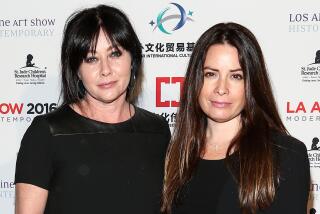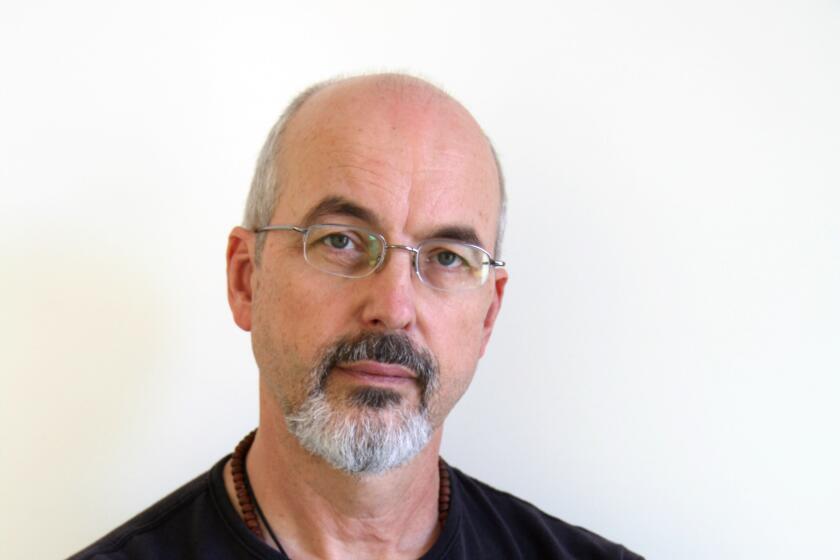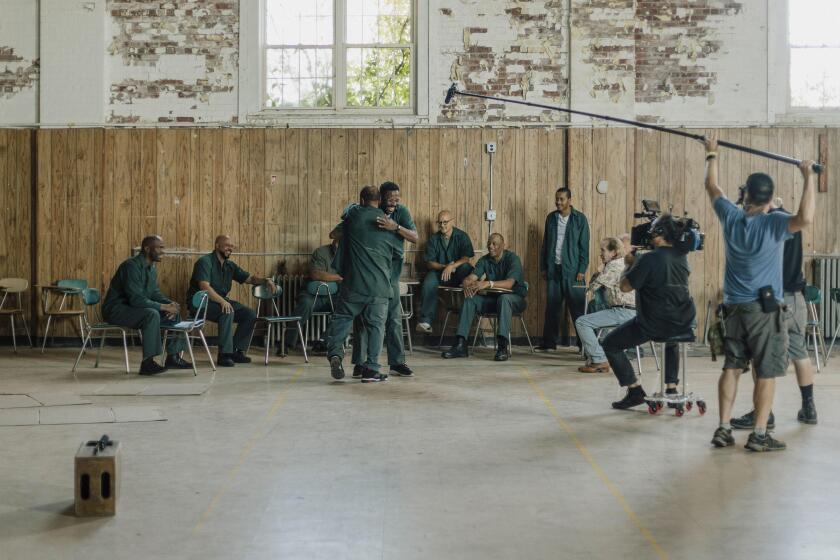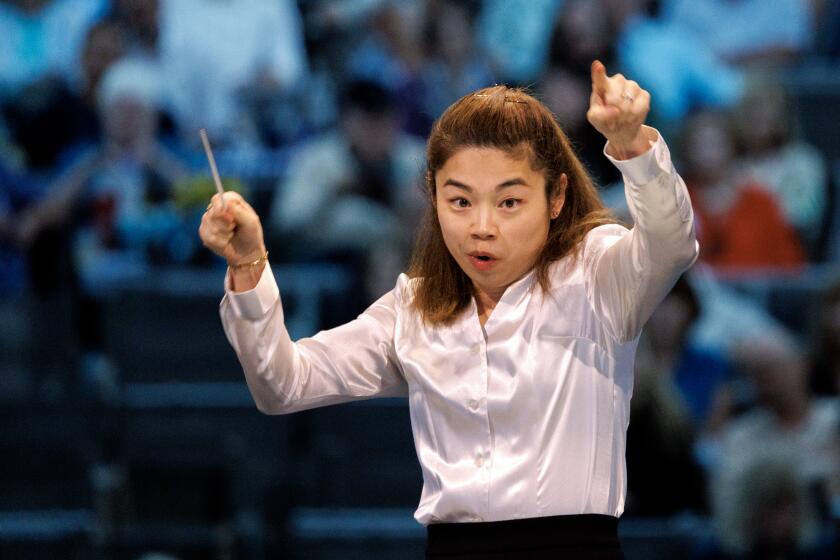Boldness with a human touch
It’s often said that artists who grew up with the Internet do not appreciate the tactility of painted surfaces and that they seem to see everything as if it were a disembodied image. Rather than counteracting this lack of physicality by piling on paint in thick swipes and smears, Sush Machida Gaikotsu takes what computers do to images to the next level. He raises the stakes by making paintings that appear to be even more disembodied than digitally transmitted imagery.
The nine paintings in Gaikotsu’s third solo show in Los Angeles make his earlier works look clunky. That’s quite an accomplishment, because the Las Vegas painter’s previous pictures of cartoon-inspired fish, cats and rats were as slick as anything coming out of Sin City -- and far more riveting.
At Western Project, his 6-, 8- and 10-foot-long panels still depict stylized fish, cats and rats, as well as snakes, dragons, birds and butterflies. But the way these traditional Japanese subjects are painted reveals an artist coming into his own: moving leaps and bounds beyond the computer-generated slickness of comic book animation that is the lingua franca of his generation. These giddy, often dizzying paintings seem to be made of nothing but negative space. Not atmospheric emptiness, which is usually implied by this term and often suggests the vast, light-devouring nothingness of the void, but a type of slippery intangibility that is as difficult to pin down as it is mesmerizing, bristling with visual energy and flat-out sexy.
In “Lucky,” “Garden,” “Sakura” and “Norman Love,” the bold graphic patterns that form the scaly skin of common creatures and mythical beasts lure your eye into undulating cycles. Eventually they spin off to form nonsensical shapes and decorative flourishes whose hard-edged perfection is stunningly whimsical.
In “Classic,” “Calico” and “Adult,” Gaikotsu mixes colors with impressive dexterity, taking your eye on sensuous rides from icy whites to gentle lemon yellows, or from racy pinks to their palest, cherry-blossom tints.
Sometimes the play between figure and ground (or shape and space) gets so confusing that it seems as if you are looking at the world reflected through a house of mirrors. But Gaikotsu is not simply a visual trickster. His whiplash compositions shift the conversation between computers and paintings into high gear, where they transform perception and enrich experience as they drive us into the future.
Western Project, 3830 Main St., Culver City, (310) 838-0609, through June 10. Closed Sundays and Mondays. www.western-project.com
One scene, but plenty of pathos
In a star-struck, celebrityobsessed culture, it’s heartening to see Jonathan Pylypchuk’s three short movies at China Art Objects Galleries. None includes a single star, lasts more than a few minutes or appears to have cost more than $50 to script, stage and shoot. Yet the pathos Pylypchuk wrangles from his one-scene dramas is potent and complex, including sorrow, guilt, pity, contempt, anger, bemusement and confusion.
The materials Pylypchuk uses are simple: scraps of wood, fabric and carpet padding make up the dollhouse-size sets. The cinematography is point-blank, the lighting bare bones, the dialogue mundane, the editing uninspired, the soundtracks pirated and the stories pedestrian. The actors steal the show.
Each is a puppet made from a real hot dog, broken chopsticks run through a pencil sharpener, twisted pipe cleaners, homemade clothing and other odds-and-ends common to the basement workshops of do-it-yourself crafters. Despite the scrappy props and cliched scenes, the movies are captivating.
Imagine the Mr. Bill skit from “Saturday Night Live” crossed with a carnivore version of Mr. Potato Head.
In one movie, benign comedy turns into sidesplitting slapstick before turning into shameful violence in a movie about a confrontation on a nude beach. Another, “Dating Game,” restages the 1960s game show as a corny farce that shares much with today’s reality-based programming.
And “Meals on Wheels” lays bare the harrowing intimacies of a low-wage, service-based economy caught in a downward spiral. Suffused with fear, helplessness and repressed rage, it raises profoundly human questions about family relationships and the viciousness of life in a utilitarian society.
Also displayed are Pylypchuk’s hastily sketched storyboards and the sets he built for his movies (with rubber hot dogs in place of real ones). The drawings are mere souvenirs.
But the funky dioramas function as 3-D stills. They invite even greater interpretive freedom than the movies, allowing you to imagine stories that make you laugh and cry as you scratch your head. If Hollywood were as efficient as Pylypchuk, there would be no box office slump.
China Art Objects Galleries, 933 Chung King Road, (213) 613-0384, through June 6. Closed Sundays, Mondays and Tuesdays.
When feelings are in conflict
The bright colors, crisp contours, funny shapes and squiggly lines in Max Jansons’ abstract paintings suggest carefree hedonism. Such giddy indulgence has long been associated with art made in Southern California. But there’s more to the 32-year-old painter’s evocations of groovy whimsy than retronostalgia.
At Christopher Grimes Gallery, Jansons manages to fuse the “oh-wow” atmosphere of a mind-bending party with the inevitable letdown of the morning after. This supple superimposition of pleasure and regret, glee and melancholy, optimism and despair transforms his four sofa-scale paintings into timely meditations on a culture that no longer believes in its founding ideals yet has nothing to put in their place.
“The Sad Science” looks like a super-size paisley pattern that ran out of gas and had to be abandoned. Its slithering curves and silhouetted shapes do not cohere in a harmonious whole. Instead, each patterned blob keeps to itself, a lonely fragment segregated from its counterparts by a moat of muddy brown.
A jet-black shadow falls across half of “The Ocean Hides All Tears.” The other half of its beautifully painted surface is electric blue exuberance -- bulbous organic forms gently interlinking or snuggling up against one another. Together, the halves add up to bittersweet poignancy; joy and stoicism mix with sophisticated simplicity.
Lava lamps and smoke rings appear to have inspired “The Veil” and “The Last Still Life, Singed and Stained.” The first suggests half-hearted decadence, an outlook too doubt-riddled to take anything at face value. In the second, a bone-white skull emerges from swirls of inky blackness, forming a contemporary memento mori.
At a time when the art market has driven itself into a frenzy feeding on works by artists just out of graduate school, it’s refreshing to see that Jansons’ L.A. solo debut comes eight years after he graduated. Maturity cannot be hurried. And it’s exciting to imagine what he will do next, with even more experience behind him.
Christopher Grimes Gallery, 916 Colorado Ave., Santa Monica, (310) 587-3373, through May 20. Closed Sundays and Mondays.
The instability of American culture
Unlike most diptychs, which consist of two panels hung side by side, each half of Ben Peterson’s big diptych at Mary Goldman Gallery leans against an opposite wall of the room. Together they make American society look like a house of cards -- elaborate, fascinating and so flimsy that it might be blown over by the slightest shift of wind.
Although his art is all about instability, it is built on solid precedents. Toba Khedoori’s huge drawings of isolated objects and Robert Gober’s faux interiors lie behind Peterson’s resonant L.A. debut.
On the left is a terrifically detailed ink-and-graphite drawing of three pre-built sheds. Designed to resemble a log cabin, a small-town church and a red barn, such sheds are often found in suburban backyards, storing tools homeowners use to keep their lawns tidy.
In Peterson’s drawing, the sheds represent the transformation of the American landscape -- from frontier to farm to suburban sprawl, all sanctified by religion. Crumbling freeway sound barricades stand behind the sheds, as do construction cones, sawhorses, folding chairs, lamps and football goal posts.
On the right, a similarly sized and equally detailed drawing depicts a hillside of coffee plants sustained by an ad hoc irrigation system. Tents, laptops and a jampacked bulletin board occupy the foreground. In the background, on the other side of the freeway barricade, two of the three sheds are visible.
By giving visitors front and back views of the same landmass, Peterson’s drawings float like small islands of bright color in the center of the paper’s pristine whiteness. The 5- by 8-foot drawings are push-pinned to 8-by-12 sheets of drywall painted white, decorated with real floorboards, topped with moldings and backed with a layer of fiberglass insulation.
By mounting his drawings on chunky, sculptural elements, Peterson links the temporary nature of art exhibitions to the subjects of his drawings. The ephemerality of culture meets the precariousness of the landscape.
Mary Goldman Gallery, 932 Chung King Road, (213) 617-8217, through June 3. Closed Sundays, Mondays and Tuesdays. www.marygoldman.com
More to Read
The biggest entertainment stories
Get our big stories about Hollywood, film, television, music, arts, culture and more right in your inbox as soon as they publish.
You may occasionally receive promotional content from the Los Angeles Times.






